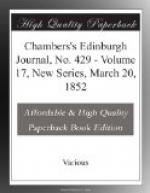’When my beloved learnt
the chess-play of cruelty,
In the very beginning of the
game her sweet cheek
(rukh) took my heart captive.’
It served also to point riddles, some of which exhibit remarkable ingenuity, as shewn by the following example, where the name of Mohammed is enigmatically embodied. It is thus rendered:
’The vow of Moses twice
repeat;
The principles of life and
heat;
The squares of chess, in order
due,
Must take their place between
these two;
When thus arranged, a name
appears,
Which every Muslim heart reveres.’
The solution, as given by a reverend ulema of Constantinople to a learned German who could not solve the mystery, is: ’Take the “vow of Moses,” which is 40; double it, and it becomes 80, equivalent to the two Mims in the name Muhammed. Place under these the bases of the temperaments—that is, the elements—which are four (the power of the letter D); then take the number of the houses (or squares) of chess, which are eight in a row, and place it (8 being equal to the letter H) between the two Ms, and you have the name of the prophet, Muhammed (MHMD.’)
‘It has been necessary,’ observes Mr Bland, ’to turn the Arabic commentary a little, in order to make the solution more intelligible to those unacquainted with the trick of Eastern riddles. Some further explanation is also required to illustrate the solution itself. The vow of Moses refers to his forty days’ fast; the four temperaments—the bile, the atrabile, phlegm, and blood—are represented in the Arabian system of physics by the four elements, which are considered to be connected with them; the figures refer to the numerical power of the abjad, or alphabet; and the enigma itself has been attributed, though on uncertain grounds, to Ali, the son-in-law of the prophet.’
‘THE SUCCESSFUL MERCHANT.’




